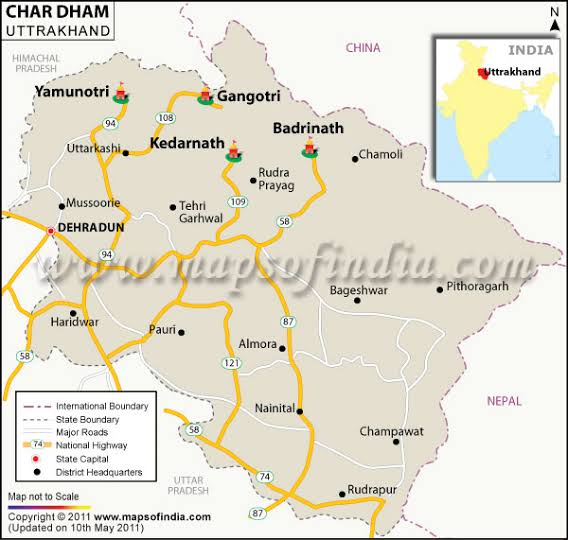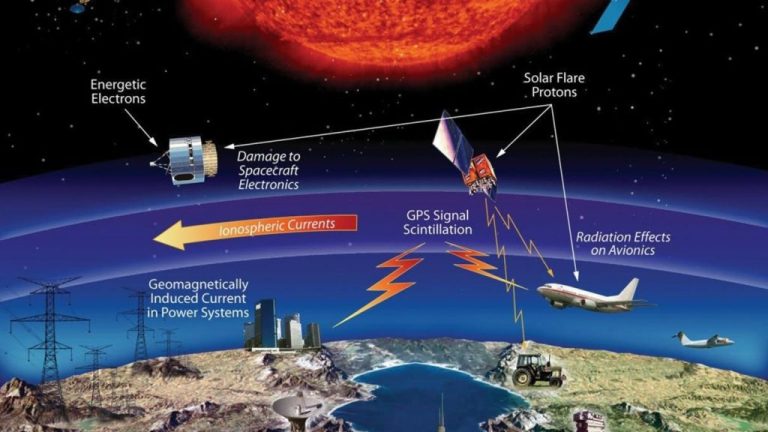Contents:
- Chardham highway project
- India: Inviolability of UN premises must be respected
- Frequent Train accidents and safety challenges
- Durga Puja Festival
- Geomagnetic storm
- PM internship scheme
Chardham highway project
Context:
The Border Roads Organisation (BRO) has said that widening of the Gangotri road won’t violate SC order.
Relevance:
GS-III Environment and Ecology, Industry and Infrastructure
Dimensions of the Article:
- Details
- What are Eco-Sensitive Zones (ESZs)?
- Activities Allowed in ESZs
- Chardham Project
Details:
- Recently, the Border Roads Organisation (BRO) has said that the proposed widening of the Chardham project’s Gangotri-Dharasu stretch in the Bhagirathi Eco-Sensitive Zone (BESZ) is not in violation of Supreme Court’s December 2021 order.
- The Supreme Court (SC) in its December 2021 judgement notified the Rishikesh-Gangotri road as a strategic road and allowed widening and rehabilitation with paved shoulders.
- The agency made this defence in response to a representation of Uttarkashi-based civil society members sent to the Union Environment Ministry.
- Himalayi Nagrik Drishti Manch, a civil society organisation, had alleged that BRO was widening the Gangotri-Dharasu stretch in the fragile BESZ without due environmental impact assessment studies.
- It also said that the project had proposed to build a bypass contrary to recommendations by the apex court appointed high-powered committee (HPC).
- Hence, the organization sought cancellation of two proposals seeking forest clearance for components of the widening work.
What are Eco-Sensitive Zones (ESZs)?
- Eco-Sensitive Zones or Ecologically Fragile Areas are areas within 10 kms around Protected Areas, National Parks and Wildlife Sanctuaries.
- ESZs are notified by MoEFCC, Government of India under Environment Protection Act 1986.
- In case of places with sensitive corridors, connectivity and ecologically important patches, crucial for landscape linkage, even area beyond 10 km width can also be included in the eco-sensitive zone.
- The basic aim is to regulate certain activities around National Parks and Wildlife Sanctuaries so as to minimise the negative impacts of such activities on the fragile ecosystem encompassing the protected areas.
Activities Allowed in ESZs
- Prohibited activities: Commercial mining, saw mills, industries causing pollution (air, water, soil, noise etc), establishment of major hydroelectric projects (HEP), commercial use of wood, Tourism activities like hot-air balloons over the National Park, discharge of effluents or any solid waste or production of hazardous substances.
- Regulated activities: Felling of trees, establishment of hotels and resorts, commercial use of natural water, erection of electrical cables, drastic change of agriculture system, e.g. adoption of heavy technology, pesticides etc, widening of roads.
- Permitted activities: Ongoing agricultural or horticultural practices, rainwater harvesting, organic farming, use of renewable energy sources, adoption of green technology for all activities.

- Char Dham Expressway National Highway is a proposed two-lane (in each direction) express National Highway in the state of Uttarakhand.
- Under the prestigious ‘Char Dham’ road project costing about ₹12,000 crore, BRO is constructing 250 km of national highway leading to the holy Hindu shrines of Gangotri and Badrinath.
The proposed highway will complement the under-development Char Dham Railway by connecting the four holy places in Uttarakhand which are:
- Badrinath
- Kedarnath
- Gangotri
- Yamunotri
The roads will be widened from 12m to 24m and the project will involve construction of tunnels, bypasses, bridges, subways and viaducts.
All of these four sites are devoted to a specific deity. Gangotri is dedicated to the Goddess Ganga, Yamunotri is dedicated to the Goddess Yamuna, Kedarnath is dedicated to Lord Shiva and is one of the 12 jyotirlingas and Badrinath, is dedicated to Lord Vishnu.
-Source: The Hindu, The Indian Express
India: Inviolability of UN premises must be respected
Context:
Recently India expressed concern over the “deteriorating” security situation in parts of West Asia.
- India said that Inviolability of UN premises must be respected by all, and appropriate measures (should be) taken to ensure the safety of UN peacekeepers and the sanctity of their mandate.
- The above statement was issued by the MEA following an alleged Israeli military strike at an observation post belonging to the United Nations Interim Force In Lebanon (UNIFIL) peacekeeping force at its main base at Naqoura in southern Lebanon.
Relevance:
General Studies Paper 2 (International Relations)
The ongoing conflict in West Asia is characterized by a complex, multi-layered struggle involving multiple actors—Israel, Hamas, Hezbollah, and their respective international backers. The situation has recently escalated following Hamas’s deadliest attack on Israel in decades, leading to a brutal Israeli response. The conflict now encompasses not only the Israel-Palestine confrontation but also a broader geopolitical struggle that includes regional powers like Iran and Saudi Arabia and global actors such as the U.S. and Russia.
- Background of the Conflict:
The Israel-Palestine conflict is rooted in historical disputes over territory, statehood, and national identity. The recent attack by Hamas, killing over 1,200 Israelis and taking more than 200 hostages, marked a significant escalation in hostilities. In response, Israel launched a full-scale military campaign in Gaza, triggering widespread destruction and displacement. - Two Diverging Narratives:
Israel perceives the conflict as an “existential war” against terrorism, aimed at securing its borders and eliminating militant threats. For Palestinians, the conflict is a struggle for liberation from Israeli occupation and recognition of their rights. The divergent narratives complicate any peace efforts, as both sides view the conflict through fundamentally different lenses. - Geopolitical Dimensions:
The conflict is not limited to Israel and Hamas. Iran-backed Hezbollah has ramped up its military activities in northern Israel, creating a second front. Saudi Arabia, which was on the brink of normalizing relations with Israel as part of the Abraham Accords, has been drawn into the conflict. The U.S. is involved in supporting Israel’s military efforts, while Russia and China have been manoeuvring diplomatically to increase their influence in the region. - The “Octopus Doctrine” and Iran’s Strategy:
Israel’s “Octopus Doctrine” aims to decapitate Iranian influence by targeting its proxies, including Hamas, Hezbollah, and the Houthis. This strategy is based on the assumption that destabilizing Iran’s regional allies will weaken its broader geopolitical influence. Iran, in turn, has used Hezbollah and Hamas to keep Israel embroiled in protracted conflicts, preventing it from projecting power beyond its borders. - The Regional Security Quagmire:
West Asia has become a conflict loop where various actors, including Iran, Saudi Arabia, and Israel, are locked in a continuous cycle of confrontation. The Abraham Accords, which sought to normalize ties between Israel and several Arab nations, have been overshadowed by the resurgence of violence. This has reinforced the perception that true peace in West Asia cannot be achieved without addressing the Palestinian issue. - Implications for Global Stability:
The conflict has broader ramifications for global security, particularly given its potential to draw in major powers. The U.S. has already increased its military presence in the region, and any miscalculation could escalate into a wider war involving multiple state actors. The Israeli-Hamas conflict also risks spilling over into neighboring Lebanon, Syria, and the Gulf, destabilizing an already fragile region. - Recommendations for a Peaceful Resolution:
- Address Core Grievances: Sustainable peace will require addressing the root causes of the conflict, including the status of Jerusalem, the right of return for Palestinian refugees, and the establishment of a sovereign Palestinian state.
- Involve Regional Stakeholders: Saudi Arabia, Egypt, and other key players must be engaged in peace talks to ensure that any agreement has regional backing.
- Reform International Mediation Efforts: The UN and other international bodies need to adopt a more assertive role in mediating peace, going beyond traditional diplomatic statements.
Conclusion:
The ongoing war in West Asia is a multi-tiered conflict with no clear endgame. Without a comprehensive approach that addresses both the immediate hostilities and the deeper political issues, the region will remain trapped in a cycle of violence and instability. Global and regional powers must act decisively to break the deadlock, or the conflict risks spiraling into a broader geopolitical confrontation with devastating consequences.
By focusing on inclusive and sustainable peace processes, the international community can hope to break the conflict loop and bring stability to a region that has seen decades of turmoil.
-Source: The Hindu, The Indian Express
Frequent Rail accidents and safety challenges
Context:
The leader of opposition in Lok Sabha recently questioned the centre over the train accident in Tamil Nadu. He said that no lessons have been learned despite many lives lost in numerous accidents .
- Recently, the Mysuru-Darbhanga Express met with an accident near Kavarapettai Railway Station in the Chennai Division, causing derailment of at least two coaches.
Relevance:
- GS2- Government Policies and Interventions
- GS3- Infrastructure
Dimensions of the Article:
- Is the Lack of Resources a Cause of Railway Accidents?
- Additional Issues that Need Attention:
- Conclusion
Is the Lack of Resources a Cause of Railway Accidents?
- Focused measures such as closing unmanned level crossings and prioritizing track maintenance have indeed improved the safety record of Indian Railways in terms of fatalities and injuries.
- However, comparing current data to past records to present an overly positive outlook is misleading.
- Modern systems and tools make achieving a zero-fatality record an attainable goal, which the Railways should aim for.
- Moreover, the Union government’s significant investment, allocating nearly 25% of its total capital expenditure to railways, means funding all necessary safety works is within reach. The lack of resources can no longer be used as an excuse.
- A statutory inquiry by the Commissioner of Railway Safety (CRS) is underway to determine the cause and responsibility for the accident.
- It is almost certain that the crew of the GFCJ container train, the station master, and possibly the signal maintainer will be held responsible for ignoring the stipulated Automatic Signal territory protocol.
- This pattern of blaming lower-level functionaries recurs with each serious accident.
Additional Issues that Need Attention:
Information Management and Communication System:
- There are additional issues that may or may not be routine but deserve more attention. First, the information management and communication of Indian Railways need scrutiny.
- While facts about the accident were still emerging, the Chairperson of the Railway Board prematurely blamed the container train crew’s disregard for signals as the primary cause.
Implementation of Kavach:
- When questioned about the slow deployment of an indigenous signaling system designed to prevent collisions, she attributed it to limited capacity within the supporting industry. If industrial capacity is insufficient, Indian Railways must support and encourage the allied industry with substantial assurances to facilitate investment in capacity building.
- Indian Railways chose the Kavach system nearly three years ago after extensive trials over 1,400 kilometers on the Southern Central Railway, opting for it over the established European ETCS Level II system.
- The project has been ongoing since then, and the slow progress suggests a lack of focus on safety works.
- If Indian Railways remains uncertain about Kavach’s effectiveness or the speed of its implementation, there is no harm in installing ETCS Level II in some key sections while Kavach is further developed.
- We have heard that Kavach is being implemented on the Delhi-Howrah and Delhi-Mumbai sections, but the target completion dates have been missed.
- It is important to consider two recommendations from the CRS report on last year’s Vizianagaram train accident.
- The report emphasized prioritizing the implementation of Kavach in Automatic Signalling territories, which are prone to collisions, and suggested faster installation in locomotives and trains before ground installations to increase the likelihood of preventing collisions.
- The Railways should focus on trunk routes and Automatic Signalling territories for faster Kavach installation, aiming for 4,000 to 5,000 km per year, which is achievable.
Views on the Existing Protocol:
- There are differing opinions on the protocol for station masters and crews in the event of an Automatic signal failure.
- The CRS report criticized this issue, highlighting poorly drafted rules that create ambiguity during Automatic signal failures. Indian Railways, like many government entities, is overstaffed.
- However, certain safety-critical categories, such as loco crew, train managers, station masters, pointsmen, and signal maintainers, require continuous work. Any vacancies in these roles cause stress and overwork for existing staff.
- Maintaining such vacancies to save costs is counterproductive. Despite nearly 20,000 vacancies for loco pilot/assistant loco pilot positions, Indian Railways issued a notice to recruit only 5,658 positions earlier this year.
- After strong criticism following this accident, this was revised to 18,799 positions, clearly indicating a careless handling of an important issue.
Lack of Action in Employing AI:
- A related issue is the lack of action in employing AI-enabled applications to enhance safety analyses and provide actionable alerts.
- AI can effectively manage extensive digital data from station data loggers and microprocessors on locomotives and trains, filtering out minor irregularities to highlight major issues and regularly presenting them to top railway management.
Conclusion:
A significant question is whether the accident was an isolated incident or if similar near misses are common in the affected section. If the inquiry reveals that such incidents were indeed frequent, it would indicate a serious management failure. It is hoped that the inquiry report will focus more on managerial issues this time, paving the way for a clear path toward a safe, accident-free Indian Railways.
-Source: The Hindu, The Indian Express
Durga Puja Festival
Context:
Durga Puja Festival Concludes In West Bengal.
Relevance:
GS-I: Art and Culture
About Durga Puja
- Durga Puja, also known as Durgotsava or Sharodotsava, is an annual Hindu festival that reveres and pays homage to the goddess Durga.
- It is an important festival in the Shaktism tradition of Hinduism.
- It is celebrated because of Durga’s victory over Mahishasur.
- It is particularly popular and traditionally celebrated in the Indian states of West Bengal, Bihar, Jharkhand, and Odisha among other states.
- It is a ten-day festival, of which the last five are of the most significance.
- In West Bengal, Durga Puja Festival draws to a close today with the immersion of idols in the rivers or other water bodies after sindoor khela and dhunuchi nach.
- Durga Puja in Kolkata received an important international recognition by making it to UNESCO’s Representative List of the Intangible Cultural Heritage of Humanity.
-Source: The Hindu, Air
Geomagnetic storm
Context:
A strong Geomagnetic storm recently hit the earth.

Relevance:
Prelims, GS-III: Science and Technology
Dimensions of the Article:
- Details
- What are Geomagnetic storms?
- What is aurora?
- Why do auroras come in different colors and shapes?
- Causes of Solar Flares and Auroras:
- Impact of Geomagnetic Storms:
- Conclusion
Details:
- A strong geomagnetic storm lit up the night sky in parts of the US during the first weekend in October.
- South Africa’s National Space Agency (SANSA) told reporters that the storm had originated from a solar flare “that erupted from sunspot 3842 on October 3”.
- Geomagnetic storms bring vibrant colours to life in some parts of the world.
- It said this was the strongest earth-facing solar flare recorded by SANSA in the past seven years.
- The eruption briefly affected high-frequency radio communications, “resulting in a total radio blackout over the African region which lasted for up to 20 minutes”.
What are Geomagnetic storms?
- Geomagnetic storms are intense disturbances in Earth’s magnetosphere, driven by the efficient transfer of energy from the solar wind into Earth’s surrounding space environment.
- These storms are primarily triggered by variations in the solar wind, which significantly impact the currents, plasmas, and magnetic fields within Earth’s magnetosphere.
- Persistent high-speed solar wind and a southward-directed solar wind magnetic field, which opposes Earth’s magnetic field, are key conditions that facilitate energy transfer from the solar wind to Earth’s magnetosphere, leading to geomagnetic storms.

What is aurora?
- An aurora, also known as the polar lights or aurora Polaris, is a natural light display in Earth’s sky, predominantly seen in high-latitude regions (around the Arctic and Antarctic).
- There are two types of aurora – the aurora borealis and aurora australis – often called the northern lights and southern lights.
- Conditions to witness the aurora lights: a clear sky, no clouds, and total darkness.
- Auroras display dynamic patterns of brilliant lights that appear as curtains, rays, spirals or dynamic flickers covering the entire sky.
- Auroras are the result of disturbances in the magnetosphere caused by solar wind.
- These disturbances alter the trajectories of charged particles in the magnetospheric plasma.
- These particles, mainly electrons and protons, precipitate into the upper atmosphere (thermosphere/exosphere).
- The resulting ionization and excitation of atmospheric constituents emit light of varying colour and complexity.
- The form of the aurora, occurring within bands around both polar regions, is also dependent on the amount of acceleration imparted to the precipitating particles.
Why do auroras come in different colors and shapes?
- The color of the aurora depends on which gas — oxygen or nitrogen — is being excited by the electrons, and on how excited it becomes. The color also depends upon how fast the electrons are moving, or how much energy they have at the time of their collisions.
- High energy electrons cause oxygen to emit green light (the most familiar color of the aurora), while low energy electrons cause a red light. Nitrogen generally gives off a blue light.
- The blending of these colors can also lead to purples, pinks, and whites. The oxygen and nitrogen also emit ultraviolet light, which can be detected by special cameras on satellites.
Causes of Solar Flares and Auroras:
- Solar flares, or coronal mass ejections (CMEs), are the result of peak solar activity caused by unstable magnetic fields on the Sun’s surface.
- CMEs vary in severity, from G1 (mild) to G5 (severe).
- When these charged particles reach Earth’s atmosphere, they interact with atmospheric gases, producing the northern lights, or aurora borealis.
Impact of Geomagnetic Storms:
Ionosphere Disturbances:
- Geomagnetic storms heat and distort the ionosphere, disrupting long-range radio communications reliant on sub-ionospheric reflection and degrading GPS communications.
Satellite Operations
- Ionospheric expansion during storms complicates satellite orbit control.
- Satellite electronics may suffer damage from accumulated static-electric charges, posing risks to both satellites and astronauts.
Earth Surface Effects:
- On Earth’s surface, rapid magnetic field shifts due to space currents can cause voltage surges, potentially leading to blackouts in power grids.
Indian Context Example:
- In India, disruptions in GPS services during geomagnetic storms can affect navigation systems used in transportation and aviation. Additionally, the vulnerability of power grids, like those managed by Power Grid Corporation of India, to voltage surges during these storms highlights the importance of monitoring and mitigating such events.
Conclusion
- Geomagnetic storms significantly influence Earth’s magnetosphere, affecting radiation belts and causing ionospheric and thermospheric alterations.
- These storms lead to increased ionospheric density, exerting additional drag on low-Earth orbiting satellites and causing horizontal density fluctuations that can distort radio signals and compromise GPS accuracy.- In the Indian context, understanding and preparing for the
- impacts of geomagnetic storms is crucial to safeguarding critical infrastructure and maintaining the reliability of communication and power systems.
-Source: The Hindu
PM internship scheme
Context:
Recently, the Finance Minister announced that unemployed youth can apply for PM internship scheme from October 12.
Relevance:
General Studies Paper 2 (Governance)
Dimensions of the Article:
- About PM Internship Scheme
- Challenges in Implementation
- Recommendations for Effective Implementation
- Expected Outcomes and Scalability
About PM Internship Scheme:
- The PM Internship Scheme is part of a broader five-scheme initiative to address skill gaps and enhance youth employability. It aims to create one crore internships by March 2029, with the first phase targeting 1.25 lakh interns for a year-long, on-the-job training program. This scheme is primarily Centre-funded and seeks to match young job-seekers with companies willing to provide practical skills training.
- Potential Benefits of the Scheme:
- Bridging Skill Gaps: The program seeks to bridge the gap between academic learning and practical job skills. By collaborating with firms, the scheme can address the issue that employers often cite: graduates lack real-world skills.
- Certification and Job Market Readiness: Firms will issue certifications to interns, making them more attractive candidates for future job roles. This could significantly improve youth employability, especially in sectors like manufacturing and services.
- Support for Job Creation: With 4.1 crore internships planned, the scheme has the potential to absorb a substantial portion of unemployed youth, reducing overall unemployment rates.
Challenges in Implementation:
- Regional Disparities in Job Availability: Placement of interns within or near their district may not be feasible in less industrialized states such as Bihar or Jharkhand, where job opportunities are limited. This could lead to disparities in participation and outcomes.
- High Dropout Rates: Ensuring that interns complete their full tenure and transition smoothly into the job market will require continuous monitoring and mentorship.
- Soft Skills Training: Beyond technical training, modern workplaces demand soft skills such as communication, teamwork, and digital literacy. The scheme must integrate these into its design.
- Industry Collaboration: Sustained partnerships with private firms are essential. However, voluntary participation may limit the number of companies willing to engage, especially in low-growth sectors.
Recommendations for Effective Implementation:
- Localized Adaptation: Tailor the scheme’s implementation strategy based on regional industrial profiles. For less-developed regions, focus on sectors like agriculture, micro-enterprises, and local industries.
- Incorporate Mentorship Programs: Pair interns with experienced professionals to guide them through the internship, ensuring they gain meaningful insights and skills.
- Monitoring and Feedback Mechanisms: Establish a robust feedback mechanism to track dropout rates, intern satisfaction, and skill acquisition, allowing for mid-course corrections.
- Expand Industry Involvement: Provide incentives for more companies, especially MSMEs, to participate. This could include tax benefits, reduced compliance burdens, or shared training costs.
Expected Outcomes and Scalability:
The pilot project’s success will be measured by the employability and retention of interns post-training. If the scheme can demonstrate value to both youth and employers, scaling it to one crore internships by 2029 will be feasible. The lessons learned from the pilot phase should be used to refine the design, ensuring that the program is sustainable and impactful.
Latest Data and Numbers:
- Target: 4.1 crore internships over five years.
- Pilot Phase: 1.25 lakh internships starting December 2024.
- Youth Unemployment Rate: Currently higher in states like Bihar and Jharkhand, which lack industrial presence.
-Source: The Hindu





